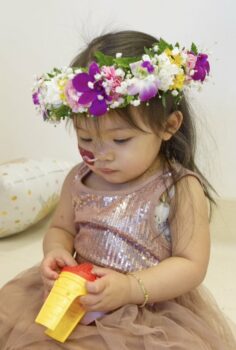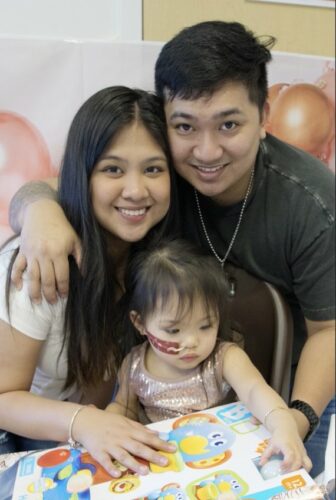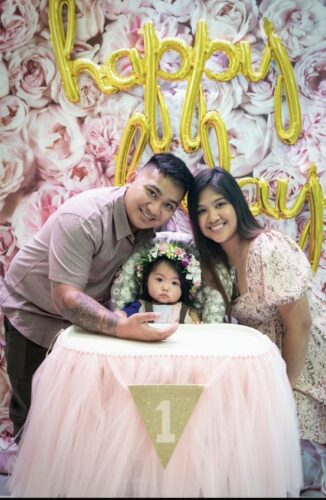
In July 2021, Kaelyn, a seemingly healthy, happy 10-month-old, woke up one morning with a puffy face. Her parents, Christine and Jerome, assumed she was having an allergic reaction. They took her to the nearest hospital in their hometown of Honolulu, Hawaii, where she underwent various tests to determine the cause.
In the hospital, Kaelyn’s condition deteriorated, and she was transferred to the Intensive Care Unit (ICU), where Christine and Jerome learned their daughter’s heart function was severely diminished and she had little chance of survival without major intervention.
Kaelyn was born with left ventricular non-compaction cardiomyopathy – a condition in which the lower left heart chamber doesn’t develop properly – that went undetected throughout pregnancy and her first 10 months of life.
Kaelyn was placed on life support for five days before she was transferred to Seattle Children’s. Christine and Jerome left their jobs in Honolulu behind and flew to Seattle with just one suitcase each, having no idea how long they would stay.
At Seattle Children’s, the cardiac team told Kaelyn’s parents about the Berlin Heart, a type of Ventricular Assist Device (VAD), which is used as a bridge for patients as they wait for a heart transplant. Kaelyn would have to be on blood thinners to prevent blood clots from forming within the Berlin Heart pump.
“It wasn’t an easy decision to make, but at that point, our main focus was to make sure Kaelyn would make it. We’re glad we went with the Berlin Heart VAD. It gave our daughter a chance to live,” said Christine.

Kaelyn got her Berlin Heart VAD and was put on the transplant list at the end of July 2021. With the help and support of occupational therapy, physical therapy, speech-language therapy, Child Life, and music therapy, Kaelyn learned to sit up, walk and play, and caught up on other developmental milestones while she was on the Berlin Heart.
“Kaelyn’s IV lines and Berlin Heart didn’t stop her from being very active and do what toddlers usually do – climb on everything,” said Christine.
However, the Berlin Heart came with a restriction. It can only be unplugged for 30 minutes and then has to charge for 6 hours before it can be unplugged again. For this reason, Kaelyn had to be in her hospital room most of the time, but her care team helped keep her entertained while also making sure she was safe.
“Kaelyn never experienced any complications in all the time she was on the Berlin Heart. That’s incredible, and it’s thanks to the expertise of her care team of cardiologists, cardiac intensivists, nurses, cardiovascular pharmacists and others who are specially trained to ensure the best outcomes for kids with VADs,” said Dr. Yuk Law, Medical Director of Cardiac Transplant and Heart Failure Service at Seattle Children’s.
Meanwhile, Christine and Jerome faced new expenses living in Seattle, including Kaelyn’s healthcare costs. Thankfully, the family’s social worker, Maricel Floresca, helped connect them with Seattle Children’s Financial Counseling team. For many families who don’t qualify for government health insurance programs, Seattle Children’s has a financial assistance program, largely funded by donors, that can help cover the cost of medical care.
After four months in Seattle, Jerome began looking for work and was hired as a building maintenance technician at Seattle Children’s. “Everybody on the team is really helpful,” he said. “They’ve supported me and are flexible so I can have a schedule that works for my family.”

Because of the protracted waiting time for children at this age across the country, days of waiting turned into months, and months turned into a year and half. Finally, after more than 500 days in the hospital, Kaelyn’s care team told her parents the good news – they had a heart for Kaelyn.
“We just couldn’t believe it. We all felt happy, anxious, deeply saddened for the donor family, you name it,” said Christine.
Kaelyn’s transplant surgery occurred in early January. Everything went well and Kaelyn was discharged less than two weeks later. On Jan. 12, she was able to join her family in their new home in Lynnwood, WA for the first time.
“It’s been almost two months since Kaelyn got her new heart,” Christine said. “She’s doing better than ever. She goes to cardiology clinic multiple times a month to see how she’s doing. So far, no signs of rejection and everything’s looking great. She loves being outdoors. Just seeing her do the things she couldn’t do while she was in the hospital makes us extremely happy.”
Christine and Jerome will soon take Kaelyn to Hawaii to celebrate her third birthday.
“We can’t thank Kaelyn’s care team at Seattle Children’s enough for making sure Kaelyn got the best care possible. They didn’t give up on Kaelyn. She’s here because of them. We are forever thankful for our daughter’s generous heart donor and their family. We pray for them continuously and are very grateful that they’ve given Kaelyn this gift of life.”
Resources:
- Seattle Children’s Heart Center
- Seattle Children’s Heart Transplant Program
- What is cardiomyopathy? (seattlechildrens.org)
- Ventricular Assist Devices (VAD) – (seattlechildrens.org)
- Resources for Patients and Families (seattlechildrens.org)

